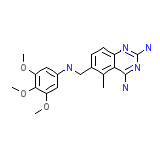Neutrexin




Neutrexin Brand names, Neutrexin Analogs
Neutrexin Brand Names Mixture
- No information avaliable
Neutrexin Chemical_Formula
C19H23N5O3
Neutrexin RX_link
http://www.rxlist.com/cgi/generic2/trimetrexate.htm
Neutrexin fda sheet
Neutrexin msds (material safety sheet)
Neutrexin Synthesis Reference
No information avaliable
Neutrexin Molecular Weight
369.418 g/mol
Neutrexin Melting Point
215-217 oC
Neutrexin H2O Solubility
31.4 mg/L
Neutrexin State
Solid
Neutrexin LogP
2.2
Neutrexin Dosage Forms
Powder for solution (containing trimetrexate glucuronate equivalent to either 200 mg or 25 mg of trimetrexate)
Neutrexin Indication
For use, with concurrent leucovorin administration (leucovorin protection), as an alternative therapy for the treatment of moderate-to-severe Pneumocystis carinii pneumonia (PCP) in immunocompromised patients, including patients with the acquired immunodeficiency syndrome (AIDS). Also used to treat several types of cancer including colon cancer.
Neutrexin Pharmacology
Trimetrexate, a non-classical folate antagonist, is a synthetic inhibitor of the enzyme dihydrofolate reductase (DHFR). During DNA synthesis and cellular reproduction, folic acid is reduced to tetrahydrofolic acid by the enzyme folic acid reductase. By interfering with the reduction of folic acid, trimetrexate interferes with tissue cell reproduction. Generally, the most sensitive cells to the antimetabolite effect of trimetrexate are those cells which are most actively proliferating such as malignant cells, dermal epithelium, buccal and intestinal mucosa, bone marrow, fetal cells, and cells of the urinary bladder. Because the proliferation of cells in malignant tissues is greater than in most normal tissues, trimetrexate may impair the growth of the malignant tissues without causing irreversible damage to normal tissues. Due to very serious and potentially life-threatening side-effects of this drug, leucovorin must be co-administered for at least 72 hours after the last dose.
Neutrexin Absorption
No information avaliable
Neutrexin side effects and Toxicity
The LD50 of intravenous trimetrexate in mice is 62 mg/kg (186 mg/m2). Myelosuppression is a dose-limiting toxic effect.
Neutrexin Patient Information
While you are being treated with trimetrexate, and after you stop treatment, do not have any immunizations (vaccinations) without your doctor’s okay. Try to avoid contact with people who have recently taken the oral polio vaccine. Check with your doctor about this. Trimetrexate can lower your blood counts (white blood cells, red blood cells, platelets). Your doctor will check your blood counts before and after each treatment to see its effect. Your doctor or nurse will give you specific instructions if your blood counts are low. Trimetrexate can decrease your white blood cell count. This can increase your risk of getting an infection. Report fever of 100.5°F or higher, or signs of infection such as pain in passing your urine, coughing, and bringing up sputum. Trimetrexate can decrease your platelet count. This can increase your risk of bleeding. DO NOT take any aspirin or aspirin–containing medicines. Report unusual bruising, or bleeding such as nosebleeds, bleeding gums when you brush your teeth, or black, tarry stools. Getting a wig before starting treatment may make it easier to deal with hair loss. Talk to your nurse or doctor about this. If your insurance does not cover it, there may be other resources to help you. Hair loss is temporary, and your hair will grow back after treatment.
Neutrexin Organisms Affected
Humans, other mammals, bacteria and protozoa














